G-osnr Estimation On Dynamic Ps-qam Channels Using Hybrid Neural Networks
HUANG; Yue-Kai ; et al.
U.S. patent application number 16/596582 was filed with the patent office on 2020-04-09 for g-osnr estimation on dynamic ps-qam channels using hybrid neural networks. This patent application is currently assigned to NEC LABORATORIES AMERICA, INC. The applicant listed for this patent is NEC Laboratories America, Inc.. Invention is credited to Yue-Kai HUANG, Ezra IP, Jiakai YU, Shaoliang ZHANG.
| Application Number | 20200112367 16/596582 |
| Document ID | / |
| Family ID | 70052531 |
| Filed Date | 2020-04-09 |
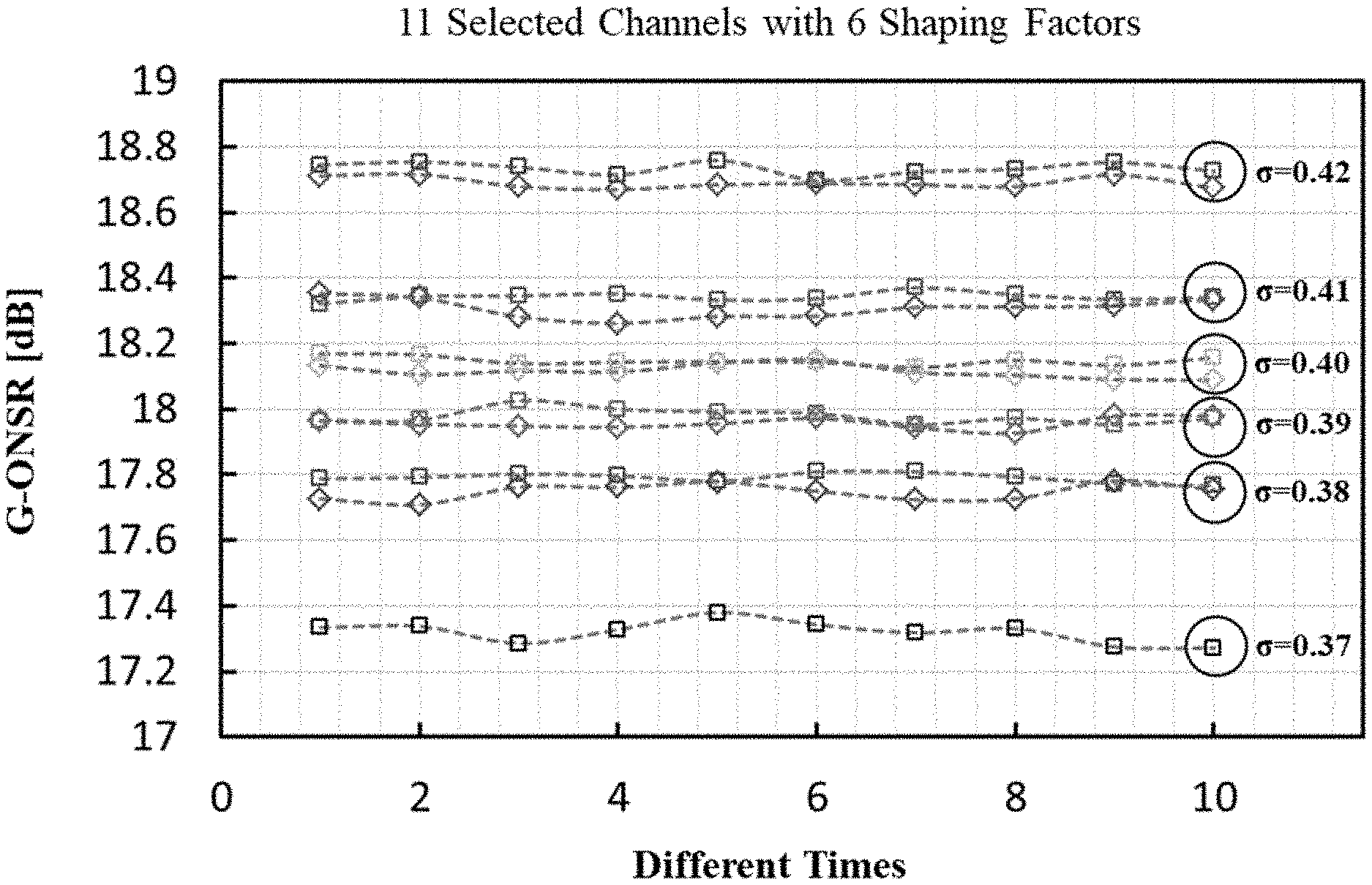
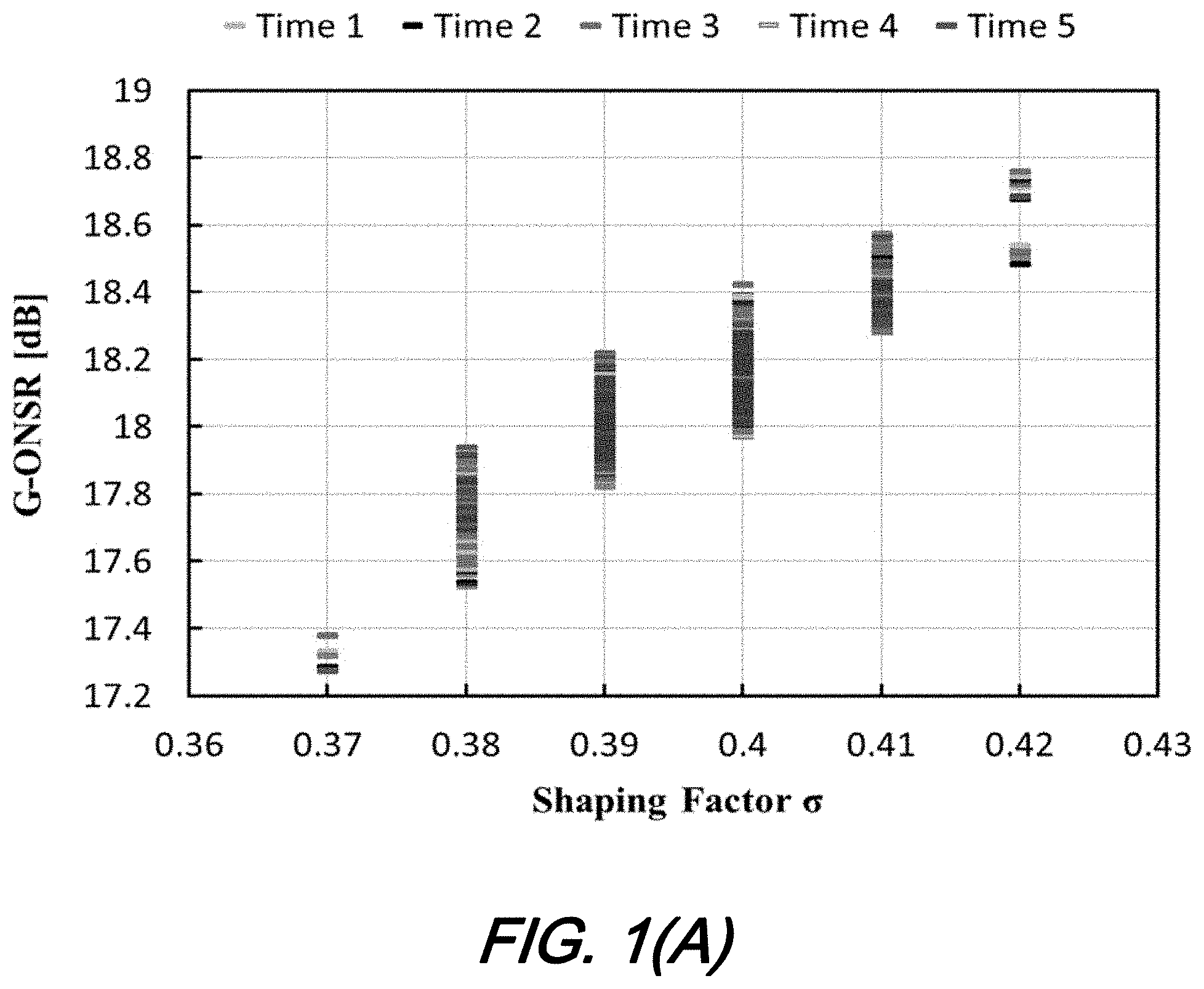
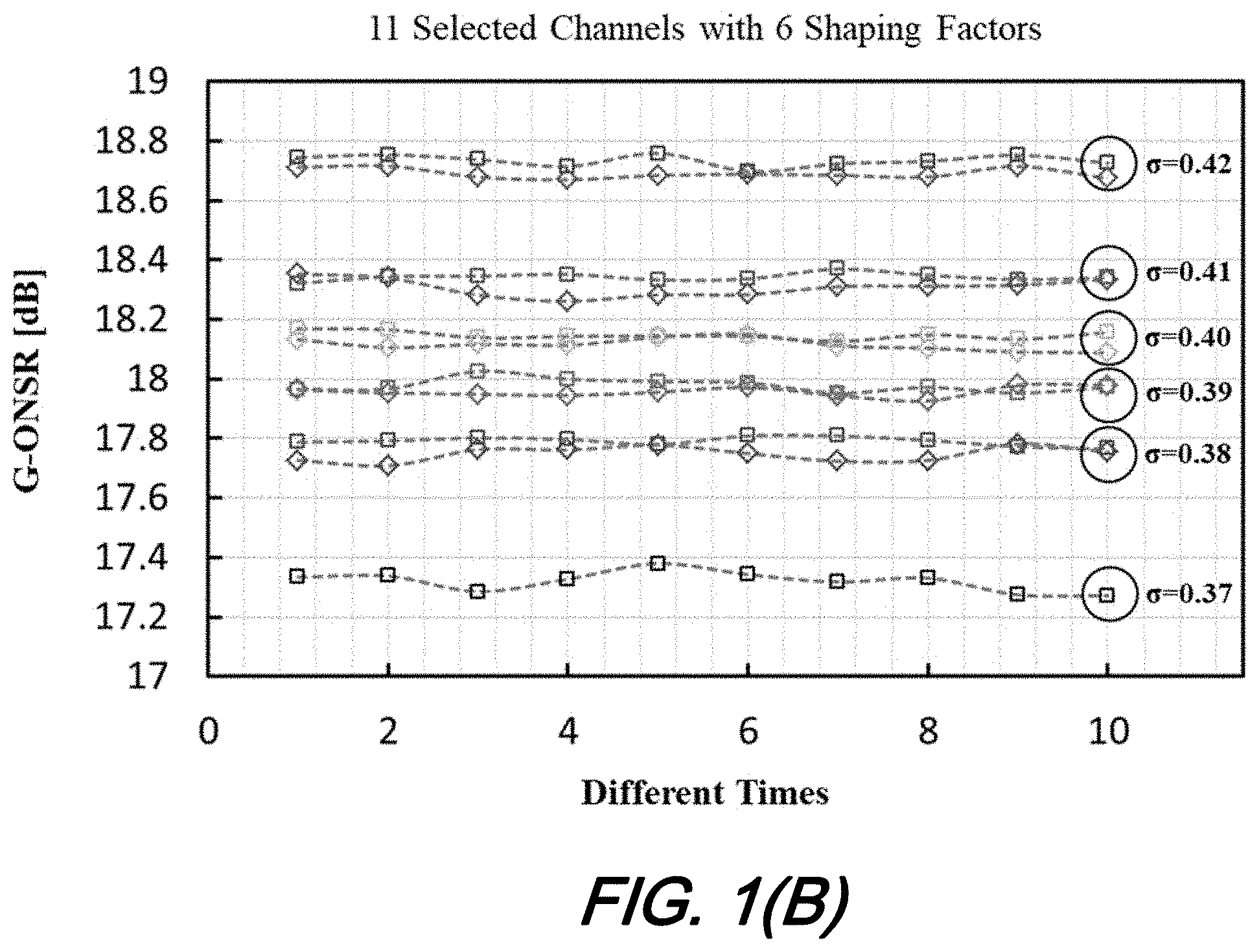
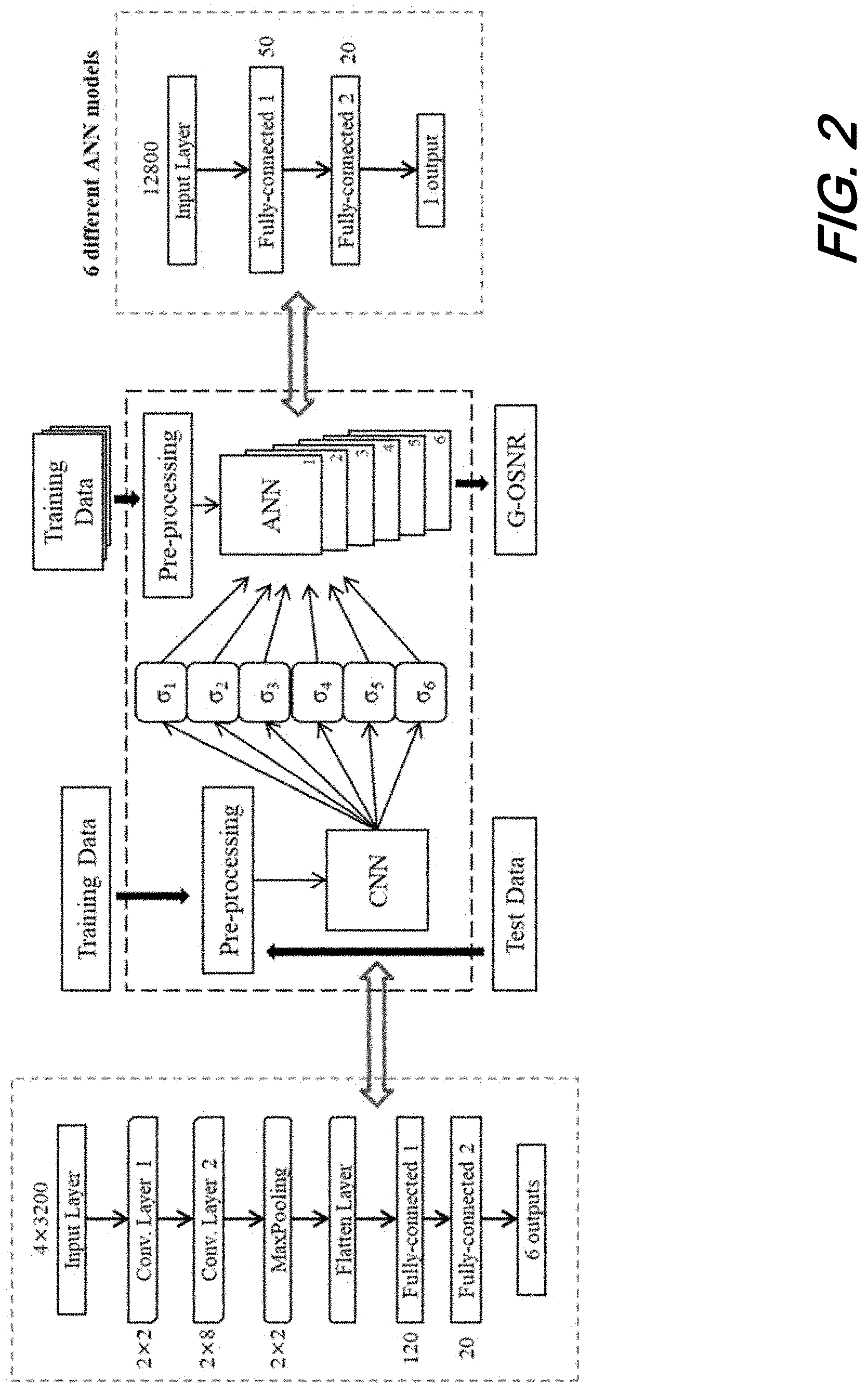
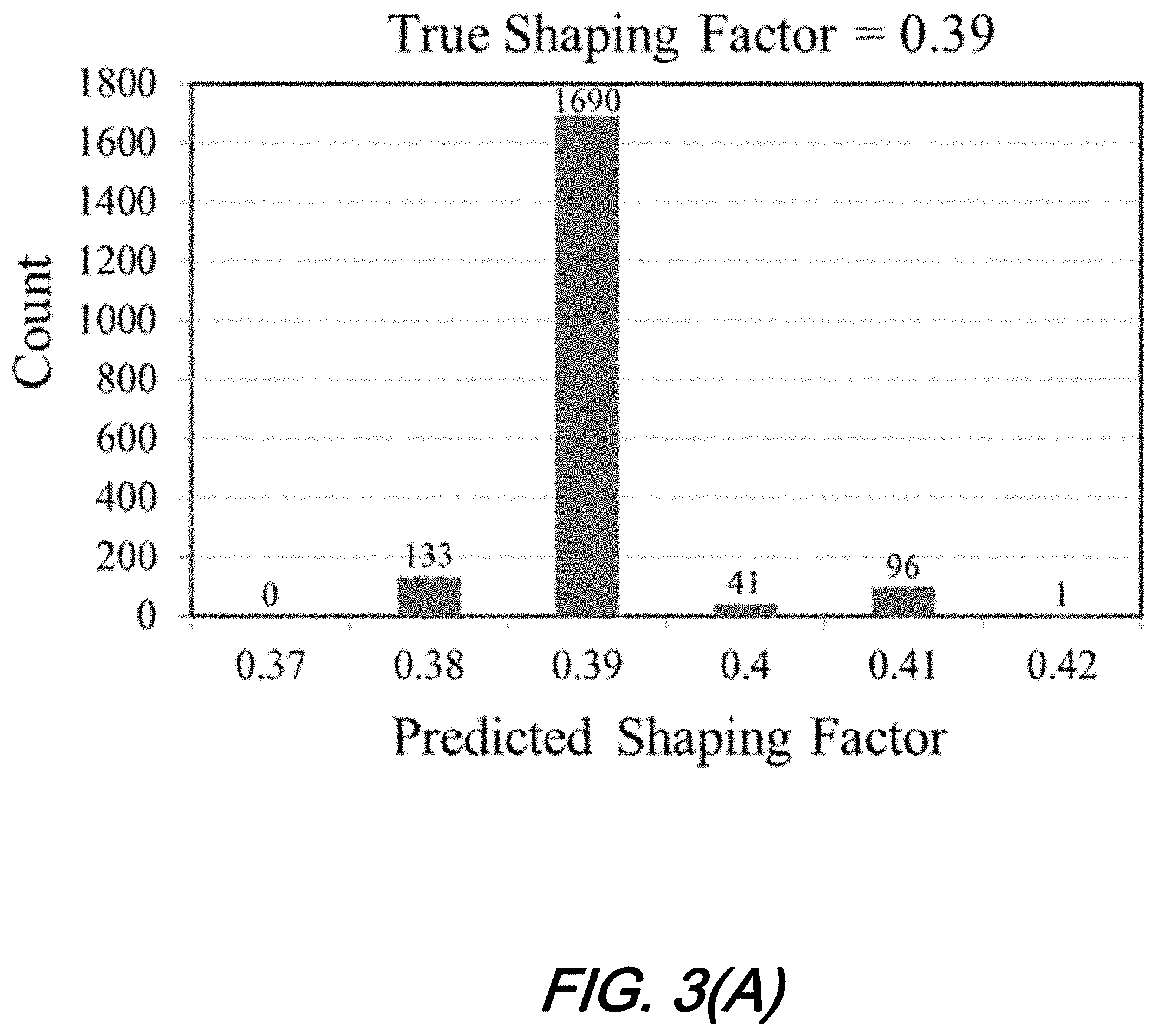
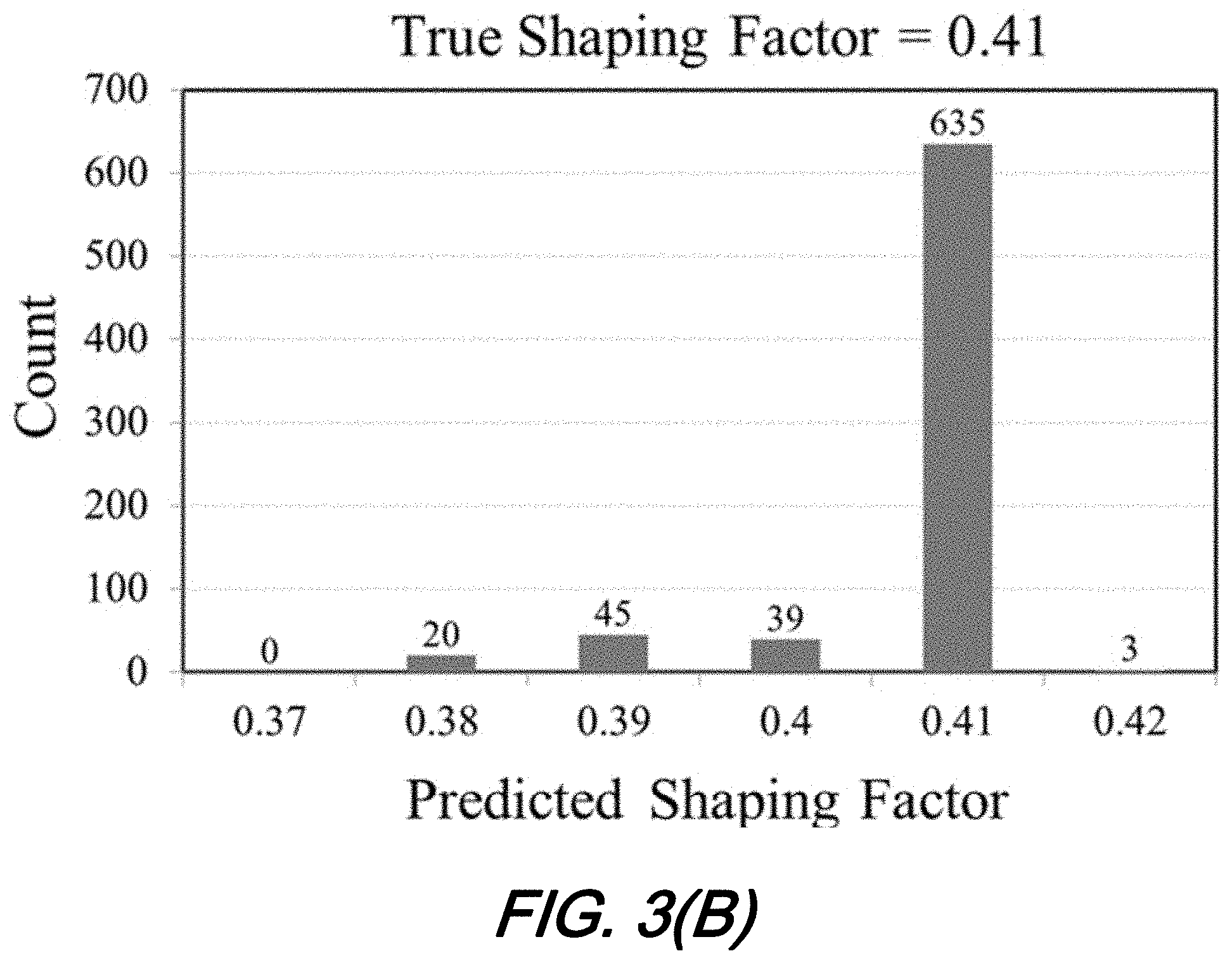

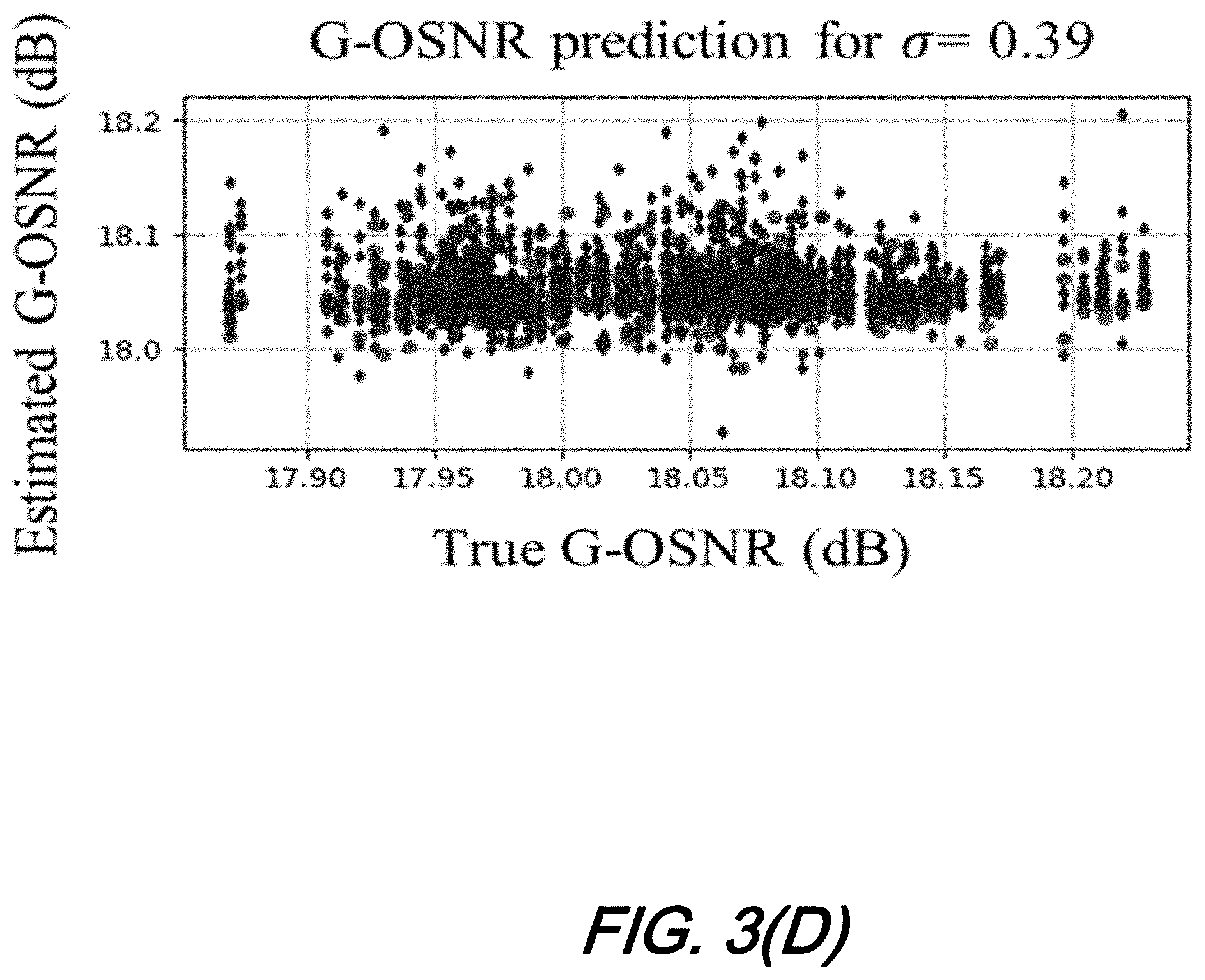
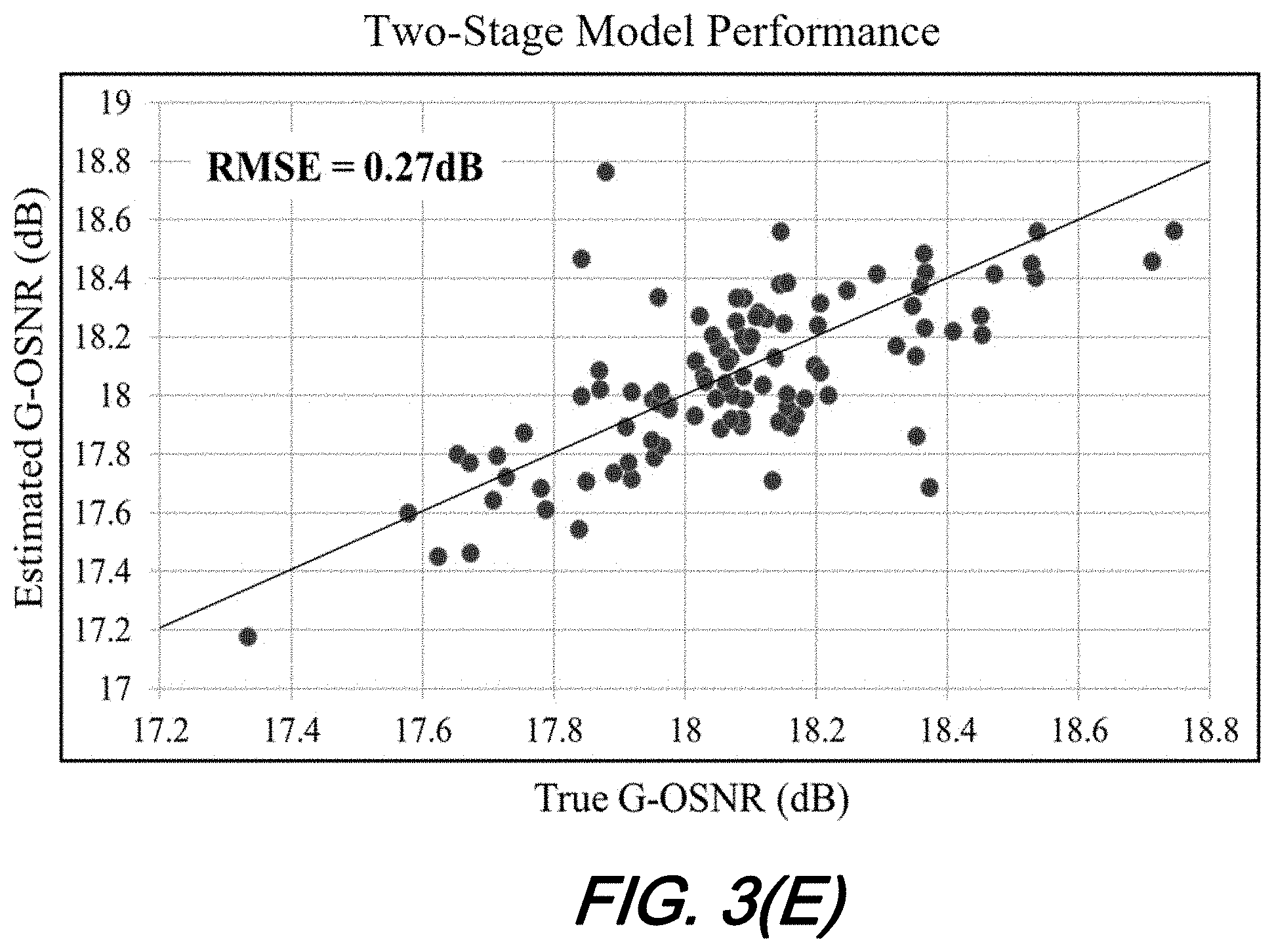

| United States Patent Application | 20200112367 |
| Kind Code | A1 |
| HUANG; Yue-Kai ; et al. | April 9, 2020 |
G-OSNR ESTIMATION ON DYNAMIC PS-QAM CHANNELS USING HYBRID NEURAL NETWORKS
Abstract
Aspects of the present disclosure describe systems, methods and structures in which a hybrid neural network combining a CNN and several ANNs are shown useful for predicting G-ONSR for Ps-256QAM raw data in deployed SSMF metro networks with 0.27 dB RMSE. As demonstrated, the CNN classifier is trained with 80.96% testing accuracy to identify channel shaping factor. Several ANN regression models are trained to estimate G-OSNR with 0.2 dB for channels with various constellation shaping.
| Inventors: | HUANG; Yue-Kai; (PRINCETON, NJ) ; ZHANG; Shaoliang; (PRINCETON, NJ) ; IP; Ezra; (WEST WINDSOR, NJ) ; YU; Jiakai; (TUSCON, AZ) | ||||||||||
| Applicant: |
|
||||||||||
|---|---|---|---|---|---|---|---|---|---|---|---|
| Assignee: | NEC LABORATORIES AMERICA,
INC PRINCETON NJ |
||||||||||
| Family ID: | 70052531 | ||||||||||
| Appl. No.: | 16/596582 | ||||||||||
| Filed: | October 8, 2019 |
Related U.S. Patent Documents
| Application Number | Filing Date | Patent Number | ||
|---|---|---|---|---|
| 62742486 | Oct 8, 2018 | |||
| Current U.S. Class: | 1/1 |
| Current CPC Class: | H04B 10/07953 20130101; H04L 27/3405 20130101; G06N 3/08 20130101; G06N 3/0454 20130101 |
| International Class: | H04B 10/079 20060101 H04B010/079; H04L 27/34 20060101 H04L027/34; G06N 3/04 20060101 G06N003/04; G06N 3/08 20060101 G06N003/08 |
Claims
1. An improved system for estimating a general optical signal to noise ratio (G-OSNR) of optical signals exhibiting probabilistic-shaped quadrature amplitude modulation (PS-QAM), said system CHARACTERIZED BY: a two-stage, hybrid neural network including a convolutional neural network (CNN) classifier in a first stage, followed by a second stage including a plurality of artificial neural networks (ANN) that estimates the G-OSNR after the CNN classification.
2. The improved system of claim 1 FURTHER CHARACTERIZED BY: the two-stage, hybrid neural network uses only raw data as input for the estimation.
3. The improved system of claim 2 FURTHER CHARACTERIZED BY: the raw data is a probabilistic-shaped quadrature amplitude modulation (PS-QAM) format.
4. The improved system of claim 3 FURTHER CHARACTERIZED BY: the PS-QAM raw data is associated with a shaping factor that is used to generate different format spectral efficiency.
5. The improved system of claim 4 FURTHER CHARACTERIZED BY: the CNN comprises several layers including 2 convolutional, 1 pooling, 1 flatten, and 2 fully-connected layers and 6 outputs for different shaping factor categorizations.
6. The improved system of claim 5 FURTHER CHARACTERIZED BY: the ANN includes a plurality of ANN regressions to estimate the G-OSNR for various probabilistic-shaped channels.
7. The improved system of claim 6 FURTHER CHARACTERIZED BY: the ANN includes two hidden layers each having 50 and 20 neurons, respectively.
8. The improved system of claim 6 FURTHER CHARACTERIZED BY: a plurality of ANN training models, at least one for each differently classified group.
Description
CROSS REFERENCE TO RELATED APPLICATIONS
[0001] This application claims the benefit of Untied States Provisional Patent Application Ser. No. 62/742,486 filed 8 Oct. 2019 the entire contents of which is incorporated by reference as if set forth at length herein.
TECHNICAL FIELD
[0002] This disclosure relates generally to optical communications systems, methods, and structures. More particularly, it describes systems, methods, and structures for generalized--optical signal to noise ratio (G-OSNR) estimation on dynamic probabilistically-shaped, quadrature amplitude modulated (PS-QAM) channels using a hybrid neural network (NN).
BACKGROUND
[0003] As is known in the optical communications arts, probabilistic-shaped quadrature amplitude modulation can improve transmission capacity in existing optical transport systems by providing transmission performance approaching theoretical values. However, quality of transmission (QoT) requirements are much higher for PS-QAM when operating at high SE regime(s). As those skilled in the art will know and appreciate--for coherent open line systems--G-OSNR is a favored indicator for evaluating transmission performance for optical communications channels independently of modulation format(s) and transponder type(s). G-OSNR not only considers the linear noise from amplified spontaneous emission (ASE) but also the nonlinear noise introduced by self-phase modulation (SPM) and cross-phase modulation (XPM).
[0004] Conventionally, to determine G-OSNR, Q factors are measured manually after the received constellations are already restored using a dedicated digital signal processor (DSP) for each modulation format in different transponders. Therefore, the estimation process is time-consuming and not particularly cost-effective, while the G-OSNR estimation results in one modulation format that may not be accurate enough for others.
SUMMARY
[0005] An advance in the art is made according to aspects of the present disclosure directed to improved systems, methods, and structures providing G-OSNR analysis and estimation. In sharp contrast to the prior art, systems, methods, and structures according to aspects of the present disclosure advantageously provides the estimation directly from raw data input PS-QAM as compared to the prior art methoeds of directly measuring transmission performance (Q or BER) or performing analysis on a recovered signal constellation.
[0006] Of particular advantage, systems, methods, and structures according to aspects of the present disclosure avoids the need for additional hardware and digital signal processing (DSP)--as is required in a typical prior art optical transponder.
[0007] Of additional distinction, systems, methods, and structures according to aspects of the present disclosure employ a two-stage hybrid neural network to estimate G-OSNR via PS-QAM formats. Advantageously, shaping factor(s) of the PS-QAM modulated channels are adjusted to accommodate a wide range of spectral efficiencies. By analyzing raw data of a coherently received signal, systems, methods, and structures according to aspects of the present disclosure can identify the shaping factor along with transmission Q-factor through the effect of a cascaded convolutional neural network (CNN) in a first stage followed by multiple artificial neural network(s) (ANN) in a second stage.
[0008] As will be readily appreciated by those skilled itn the art, given the capability of QoT estimation across different PS-QAM shaping factors--and in further contrast to the prior art--systems, methods, and structures according to aspects of the present disclosure may be employed to estimate G-OSNR for open line systems with wide operation ranges of spectral efficiency(ies--SE) while advantageously reducing estimation time(s) and computation complexity(ies) as only raw data from the received signal is required for training and prediction. Of further advantage and distinction, systems, methods, and structures according to the present disclosure may further reduce implementation cost over the prior art as only PS-QAM is required for G-OSNR analysis, instead of combining multiple analysis from different modulation formats.
BRIEF DESCRIPTION OF THE DRAWING
[0009] A more complete understanding of the present disclosure may be realized by reference to the accompanying drawing in which:
[0010] FIG. 1(A) is a plot of G-OSNR (db) vs. Shaping Factor illustrating the G-OSNR distribution for 138 channels of 6 shaping factors according to aspects of the present disclosure;
[0011] FIG. 1(B) is a plot of G-OSNR (db) vs. Different Times illustrating the G-OSNR distribution with various times for 11 selected channels according to aspects of the present disclosure;
[0012] FIG. 2 is a schematic diagram illustrating a two-stage hybrid neural network model wherein a structure of a Convolutional Neural Network (CNN) classifier is on the left, Artificial Neural Network (ANN) models are shown on the right, and model workflow is in the middle, according to aspects of the present disclosure;
[0013] FIG. 3(A), FIG. 3(B), FIG. 3(C), FIG. 3(D), and FIG. 3(E) are plots illustrating results of two-stage hybrid neural network model in which: FIG. 3(A) is a plot of Count vs. Predicted Shaping Factor illustrating classification distribution of CNN for .sigma. is 0.39; FIG. 3(B) is plot of Count vs. Predicted Shaping Factor illustrating classification distribution of CNN for which .sigma. is 0.41; FIG. 3(C) is plot of G-OSNR RMSE (dB) vs Training Epoch illustrating ANN training curve for .sigma.=0.39; FIG. 3(D) is plot of estimated G-OSNR (dB) vs True G-OSNR (dB) illustrating G-OSNR prediction results for .sigma.=0.39; ANN model performance has .sigma.=0.39; a saturation curve showing cleaner constellation according to aspects of the present disclosure; and FIG. 3(E) is plot of estimated G-OSNR (dB) vs True G-OSNR (dB) illustrating hybrid neural network performance for test data of 100 randomly selected channels--all according to aspects of the present disclosure.
[0014] The illustrative embodiments are described more fully by the Figures and detailed description. Embodiments according to this disclosure may, however, be embodied in various forms and are not limited to specific or illustrative embodiments described in the drawing and detailed description.
DESCRIPTION
[0015] The following merely illustrates the principles of the disclosure. It will thus be appreciated that those skilled in the art will be able to devise various arrangements which, although not explicitly described or shown herein, embody the principles of the disclosure and are included within its spirit and scope.
[0016] Furthermore, all examples and conditional language recited herein are intended to be only for pedagogical purposes to aid the reader in understanding the principles of the disclosure and the concepts contributed by the inventor(s) to furthering the art and are to be construed as being without limitation to such specifically recited examples and conditions.
[0017] Moreover, all statements herein reciting principles, aspects, and embodiments of the disclosure, as well as specific examples thereof, are intended to encompass both structural and functional equivalents thereof. Additionally, it is intended that such equivalents include both currently known equivalents as well as equivalents developed in the future, i.e., any elements developed that perform the same function, regardless of structure.
[0018] Thus, for example, it will be appreciated by those skilled in the art that any block diagrams herein represent conceptual views of illustrative circuitry embodying the principles of the disclosure.
[0019] Unless otherwise explicitly specified herein, the FIGs comprising the drawing are not drawn to scale.
INTRODUCTION
[0020] By way of some additional background, we begin by noting that contemporary high bandwidth services and applications, such as cloud computing, fifth-generation (5G) wireless networks, and virtual reality, are precipitating an exponential growth of transmission capacity in optical transport networks. And while deployment of new transport infrastructures has immensely increased transmission capacity to over 10-Pb/s, usage optimization of existing optical fibers in a cost-efficient manner remains a goal of network venders.
[0021] In pursuit of such cost-efficient optimization, probabilistic-shaped 256 quadrature amplitude modulation (PS-256QAM) has been pursued as one method to improve transmission capacity in already deployed optical transport systems. However, while reducing spectral efficiency (SE) gap to the Shannon limit, it requires strict transmission quality in terms of bit error rate (BER) and Q factor.
[0022] For coherent open line systems, those skilled in the art will understand and readily appreciate that general optical signal-to-noise ratio (G-OSNR) deriving from back-to-back OSNR vs. Q or BER mapping is typically employed to evaluate transmission performance. G-OSNR considers both linear and nonlinear noises other than commonly used OSNR mainly presenting amplifier spontaneous emission (ASE) noise. Traditionally, a Q factor is manually measured with complicated and expensive digital signal processing (DSP) equipment. In such a scenario, the required processing is both time-consuming and expensive to achieve.
[0023] Recently, neural networks have been employed to facilitate quality of transmission (QoT) evaluation in optical transport networks. In this disclosure, we describe a two-stage hybrid neural network model that estimates G-OSNR for deployed standard single-mode fiber (SSMF) metro networks with optimized PS-256QAM modulation format.
[0024] According to aspects of the present disclosure, raw data from 138 channels in C-band are fed into the model. A convolutional neural network (CNN)--comprising the first stage of our systems, methods, structures, and models--classifies a shaping factor of the modulation format with 80.96% accuracy. The second stage--comprising several artificial neural network (ANN) models according to each shaping factor--estimates the G-OSNR within 0.2 dB root mean square error (RMSE). Advantageously--and surprisingly--a total RMSE of estimated G-OSNR can be obtained as 0.27 dB with test data.
PS-256QAM Raw Datasets and Two-Stage Hybrid Neural Network Model
[0025] As will be readily appreciated by those skilled in the art, PS-256QAM raw datasets employed in this disclosure comprise two-direction IQ complex signals from 138.times.32-Gbaud channels of a deployed metro network with 33.3-GHz spacing in C-band. By splitting symbol data into real and imaginary parts, the data format obtained is 4.times.5,216,000 along a single channel.
[0026] Probabilistic constellation shaping follows Gaussian-distributed amplitude levels as:
p ( x i ) = 1 2 .pi. .sigma. 2 P exp ( - x i 2 2 .sigma. 2 P ) ##EQU00001## where ##EQU00001.2## P = 1 N x i .di-elect cons. C x i 2 ##EQU00001.3##
[0027] is the mean square of allowable amplitude levels. A shaping factor 6 and launch power for each channel are already optimized to guarantee maxmized throughoutput with zero BER after low-desity parity check (LDPC) decoding and minimal nonlinear penalty, respectively.
[0028] Effective OSNR are calibrated at a receiver side for all 138 channels at different instants of time. Instead of using channel frequency as a feature of datasets, shaping factor .sigma. has more direct relation to channel G-OSNR distribution as shown illustratively in FIG. 1(A). As may be observed from that plot, G-OSNR values of all 138 channels at five different time instants are categorized into 6 groups according to different shaping factors from 0.37 to 0.42 at a granularity of 0.01. As may be further observed, the G-OSNR increases as the channel assigned shaping factor increases. And for each shaping factor, channel G-OSNR values are assembled in a band around 0.4 dB.
[0029] FIG. 1(B) is a plot illustrating how the G-OSNR oscillates at various time instants of 11 selected channels from 6 shaping factors. Each channel G-ONSR value fluctuates in a 0.2 dB band.
[0030] FIG. 2 is a schematic diagram illustrating a two-stage hybrid neural network model wherein a structure of a CNN classifier is on the left, ANN models are shown on the right, and model workflow is in the middle, according to aspects of the present disclosure.
[0031] Based on the features of PS-256QAM datasets--our designed two-stage hybrid neural network model as illustrated--both CNN classifier and ANN regression use Adam optimization algorithm(s) and Standard Scaler pre-processing. Additionally, all convolutional and fully-connected layers work with rectified linear unit (ReLU) activation function.
[0032] As will be appreciated by those skilled in the art--since we have huge and complicated datasets--before the raw data are fed into the model, they are chopped or otherwise segmented into 163 segments as 4.times.3200.times.163 per channel. This advantageously simplifies the problem as local feature abstraction as image recognition. We mainly consider patch signal transmission patterns other than close relation between every signal symbol. This further decreases the complexity of the model and advantageously accelerates training time.
[0033] As may be observed from FIG. 2, the first stage of the model is a CNN classifier with 2 convolutional, 1 pooling. 1 flatten, 2 fully-connected layers, and 6 outputs for different shaping factor categorizations. Loss function is categorical cross entropy and dropout is set as 0.3. The input layer receives a segment of 4.times.3200 IQ data as a single sample.
[0034] After the CNN classifier, the G-OSNR values are closed within each group of same probabilistic-shaped channels. Then ANNs are used to consider all possible relations for all data symbols to dig out dataset information. Thus, the second stage of the model comprises several fully-connected ANN regressions to estimate G-OSNR for various probabilistic-shaped channels. The input data is flattened as 12800 before being fed to ANN. Each ANN has two hidden layers with 50 and 20 neurons, respectively. Root mean square error is chosen as loss function and dropout is 0.5. Used learning rates are less than 0.001 to ensure fine-grained granularity regression.
Illustrative Results
[0035] During the model training and test, 138-channel symbol data in 53 segments out of 163 were used to accelerate modeling time. For the CNN classifier, the total number of training samples was 53.times.138.times.4=29,256 from four different time instants. Additionally, 53.times.138=7,314 samples from another time instant are used for test. After 150 epochs training, the classifier obtains 94.73% accuracy with training data, and 80.96% accuracy with test data.
[0036] FIG. 3(A), FIG. 3(B), FIG. 3(C), FIG. 3(D), and FIG. 3(E) are plots illustrating results of two-stage hybrid neural network model in which: FIG. 3(A) is a plot of Count vs. Predicted Shaping Factor illustrating classification distribution of CNN for .sigma. is 0.39; FIG. 3(B) is plot of Count vs. Predicted Shaping Factor illustrating classification distribution of CNN for which .sigma. is 0.41; FIG. 3(C) is plot of G-OSNR RMSE (dB) vs Training Epoch illustrating ANN training curve for .sigma.=0.39; FIG. 3(D) is plot of estimated G-OSNR (dB) vs True G-OSNR (dB) illustrating G-OSNR prediction results for .sigma.=0.39; ANN model performance has .sigma.=0.39; a saturation curve showing cleaner constellation according to aspects of the present disclosure; and FIG. 3(E) is plot of estimated G-OSNR (dB) vs True G-OSNR (dB) illustrating hybrid neural network performance for test data of 100 randomly selected channels--all according to aspects of the present disclosure.
[0037] The performance of the CNN is shown in FIG. 3(A) and FIG. 3(B). Most predicted shaping factors are accurate as the channel originally assigned ones. Interestingly, some inaccurate predictions are located in neighbor shaping factors ranging from 0.38 to 0.41, while only few predicted results are located in 0.37 and 0.42. As shown in FIG. 1(A), the shaping factor based G-OSNR band is within 0.4 dB. Note that there are some overlaps between groups from 0.38 to 0.41, and the groups of 0.37 or 0.42 have certain guard gap for G-OSNR band--indicating more distinct group distribution. Accordingly, our CNN classifier reflects the distribution features of the datasets.
[0038] For ANN regression training, less than 10 channels in each shaping factor based channel group are selected. More particularly, 53 segments from 4 different time instants for a channel are used as the CNN while data from other time(s) are chosen for testing. During the ANN model training--and as will be appreciated by those skilled in the art--different groups require different number of training epoch ranging from 150 to 500 when using same learning rate.
[0039] FIG. 3(C) presents that the model achieves 0.17 dB G-OSNR RMSE for channel group of shaping factor .sigma.=0.39 after 250 training epochs. FIG. 3(D) shows the prediction results for this group. The other five ANN models also guarantee estimated G-OSNR RMSE less than 0.2 dB.
[0040] After CNN classifier and six ANN regressions are trained, 100 randomly selected channels are fed into our two-stage hybrid neural network model. The model performance is presented in FIG. 3(E). As may be observed, a total RMSE of predicted G-OSNR is obtained as 0.27 dB for the deployed SSMF metro network with high throughput PS-256QAM transmission format.
[0041] We note that as we have shown and discussed our hybrid neural network model according to aspects of the present disclosure comprising CNN and ANN will predict G-OSNR with 0.27 dB RMSE for optimized PS-256QAM raw data from deployed optical transport systems. Advantageously, systems, methods, and structures employing a model according to the present disclosure provides a cost-efficient way to modelling neural networks for optical transmission quality evaluation.
[0042] At this point, while we have presented this disclosure using some specific examples, those skilled in the art will recognize that our teachings are not so limited. In particular, a CNN classifier with 80.96% classification accuracy might be improved with more reasonable data pre-processing based constellation shaping technology. Datasets with various pre-emphasized channel power or under-optimized constellation shaping could be used to train and modify the model for more general and dynamic optical transport networks. Accordingly, this disclosure should be only limited by the scope of the claims attached hereto.
* * * * *
D00000

D00001

D00002

D00003

D00004

D00005

D00006

D00007

D00008


XML
uspto.report is an independent third-party trademark research tool that is not affiliated, endorsed, or sponsored by the United States Patent and Trademark Office (USPTO) or any other governmental organization. The information provided by uspto.report is based on publicly available data at the time of writing and is intended for informational purposes only.
While we strive to provide accurate and up-to-date information, we do not guarantee the accuracy, completeness, reliability, or suitability of the information displayed on this site. The use of this site is at your own risk. Any reliance you place on such information is therefore strictly at your own risk.
All official trademark data, including owner information, should be verified by visiting the official USPTO website at www.uspto.gov. This site is not intended to replace professional legal advice and should not be used as a substitute for consulting with a legal professional who is knowledgeable about trademark law.